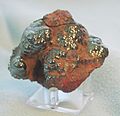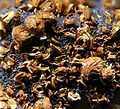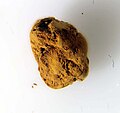Iron ochre
Appearance
| Iron ochre | |
|---|---|
 | |
| General | |
| Category | Mineral |
Iron ochre or iron ocher (Ancient Greek: ὠχρός, pale yellow, orange) — at least three iron ore minerals,[1]: 134 common abrasives and pigments with a red-brown or brown-orange hue and the powdery consistency of ocher, were known under such a trivial name. The term “iron ocher” was primarily used among mineral collectors, geologists, miners and representatives of related craft professions. It may refer to:
- Iron ochre or hematite[2]: 85 — Fe2O3,[3]: 212 a widespread iron mineral, one of the most important iron ores;
- Iron ochre or limonite[2]: 85 — Fe2O3·Н2О,[4]: 30 a mixture of secondary natural minerals, iron oxide hydrates;
- Iron ochre or goethite[4]: 30 — α-FeO(OH), a product of weathering of ores, a secondary iron mineral, the main component of limonite, is part of brown iron ores;
- Iron ochre, brown iron ocher or lepidocrocite — γ-FeO(OH),[5]: 236 a secondary mineral, a product of the oxidation of iron ore minerals, found in brown iron ores;
- Iron ochre or ferric oxide[3]: 212 — Fe2O3 (oxides of iron), which also occurs naturally as the mineral magnetite;
- Iron ochre or ferrihydrite[6]: 338 — Fe2O3·0.5H2O, is a widespread hydrous ferric oxyhydroxide mineral at the Earth's surface;
Gallery
[edit]References
[edit]- ^ Krivovichev V. G. Mineralogical glossary. Scientific editor A. G. Bulakh. — St.Petersburg: St.Petersburg Univ. Publ. House. 2009. — 556 p. — ISBN 978-5-288-04863-0
- ^ a b Thomas Egleston, Ph. D. Catalogue of Minerals and Synonyms. — Washington: Government Printing Office, 1887.
- ^ a b Sigvald Linné. Archaeological Researches at Teotihuacan, Mexico. Sigvald Linne, with a foreword by Staffan Brunius and introduction by George L. — The University of Alabama Press, 2003. — 236p.
- ^ a b Kimmo Virtanen. Geological control of iron and phosphorus precipitates in mires of the Ruukki-Vihanti Area, Central Finland. — Geological Survey of Finland, 1994; — 69 p.
- ^ R. A. Lidin, L. L. Andreeva, V. A. Molochko, edited by R. A. Lidin. Constants of inorganic substances: reference book. 3-rd ed., stereotypical. — Moscow: Drofa, 2008 г. — 685 p.
- ^ A.M.O. Mohamed. Principles and Applications of Time Domain Electrometry in Geoenvironmental Engineering. — Taylor & Francis, 2006. — 603 p.





